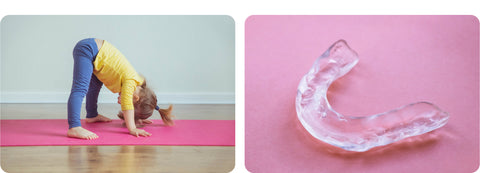Childhood bruxism is a common phenomenon that worries many parents. This article explains how to recognize bruxism in children, when to be concerned, and what solutions exist to effectively manage it. Also discover why a preventative approach from an early age is crucial to avoid complications in adulthood. Childhood bruxism is a common phenomenon that worries many parents. This article explains how to recognize bruxism in children, when to be concerned, and what solutions exist to effectively manage it. Also discover why a preventative approach from an early age is crucial to avoid complications in adulthood.
What is bruxism in children?
Childhood bruxism is characterized by the involuntary grinding or clenching of teeth, mainly during sleep. This phenomenon affects between 15% and 35% of children according to studies [1]. Although often benign, bruxism can sometimes have consequences on the child's oral health and well-being if it persists.
The different types of childhood bruxism
There are two main forms of bruxism in children:
- Sleep bruxism: it occurs at night, unconsciously
- Awakening bruxism: rarer, it occurs during the day
What are the causes of bruxism in children?
Childhood bruxism has multifactorial origins. Among the main risk factors are:
- Stress and anxiety
- Sleep disorders
- Bad posture
- Respiratory problems (sleep apnea, allergies)
- Genetic factors
A recent study has highlighted a link between certain genetic polymorphisms and the presence of bruxism in children [2]. These discoveries open new avenues for better understanding the mechanisms involved.

How to recognize bruxism in your child?
Certain signs can alert parents to the presence of bruxism in their child:
- Teeth grinding noises at night
- Jaw pain upon waking
- Abnormal wear of the teeth
- Frequent headaches
- Fatigue upon waking
It is important to consult a healthcare professional if in doubt to obtain an accurate diagnosis.
When should you be concerned about childhood bruxism?
In most cases, bruxism in children is a transient phenomenon that disappears with age. However, certain situations require treatment:
- Intense and frequent bruxism
- Significant pain
- Severe tooth wear
- Associated sleep disorders
- Impacts on the child's quality of life
A consultation with a pediatric dentist or orthodontist will allow the severity of bruxism to be assessed and appropriate treatment to be proposed if necessary.
What are the solutions for treating childhood bruxism?
Treating bruxism in children requires a comprehensive and personalized approach. The main treatment options include:
Relaxation techniques and stress management
Teaching your child breathing and relaxation exercises can help reduce stress-related bruxism. Sophrology or meditation sessions tailored to children can be beneficial.
Improving sleep hygiene
Establishing a calming bedtime routine and limiting screen time before sleep promotes better rest and may reduce nighttime bruxism.
Protective dental braces
In some cases, wearing a custom-made splint at night may be recommended to protect teeth from wear associated with bruxism.
Myofunctional rehabilitation
Targeted exercises help retrain the jaw and tongue muscles to reduce the tension responsible for bruxism.
Treatment of respiratory disorders
Managing possible sleep apnea or chronic allergies can help reduce bruxism.
How to prevent bruxism in children?
Prevention plays a key role in managing childhood bruxism. Here are some tips to limit the risks:
- Promote a calm and serene environment at home
- Encourage a balanced diet
- Limit consumption of sugars and acidic drinks
- Ensure good posture, especially while sleeping
- Practice regular physical activity
Regular monitoring of the child's oral health also allows for early detection of signs of bruxism.
The importance of early care
Although often benign, childhood bruxism should not be neglected. Appropriate treatment from a young age can:
- Limit tooth wear
- Prevent temporomandibular joint disorders
- Improve the quality of the child's sleep
- Reduce the risk of complications in adulthood
Indeed, bruxism can persist into adulthood if not treated early. This is why innovative solutions like Bruxless are being developed to provide optimal bruxism management. Although intended for adults, our revolutionary device illustrates the importance of a comprehensive and personalized approach to bruxism treatment.
Conclusion
Bruxism in children is a complex phenomenon that requires careful attention. By being vigilant for warning signs and consulting a healthcare professional if there is any doubt, parents can take effective action to protect their child's oral health. Early and appropriate treatment not only relieves symptoms but also prevents long-term complications. Don't hesitate to consult a specialist for an accurate diagnosis and personalized advice.
Sources:
[1] Serra-Negra JM, et al. Prevalence of sleep bruxism in a group of Brazilian schoolchildren. Eur Arch Paediatr Dent. 2010;11(4):192-5.
[2] Scariot R, et al. Sleep bruxism and separation anxiety trajectories were weakly associated. Sleep Med. 2022;14(2):183-8.






Related Articles
Intro